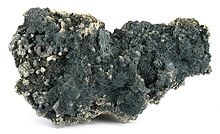User:Chris857/Boulangerite
This is the sandbox of Chris857. A sandbox is a subpage of a template or article used to test a change to the main article or template before deploying said changes. Once you have finished with the test, please erase the contents of this page leaving this box ({{Sandbox notice}}) in place. (diff) See also: Main sandbox
|
| Boulangerite | |
|---|---|
 Boulangerite, covering a block of limestone | |
| General | |
| Category | Sulfosalt mineral |
| Formula (repeating unit) | Pb5Sb4S11 |
| Strunz classification | 2.HC.15 |
| Dana classification | 3.5.2.1 |
| Crystal system | Monoclinic |
| Space group | H-M group: 2/m Space group: P21/a |
| Unit cell | a = 21.612(7) Å b = 23.543(8) Å c = 8.084(3) Å β = 100.71(2)°, Z=8[1] |
| Identification | |
| Color | Lead grey |
| Cleavage | Distinct on {100} |
| Tenacity | Brittle, flexible in thin crystals |
| Mohs scale hardness | 2.5–3 |
| Luster | Metallic, sometimes silky |
| Streak | Brownish |
| Diaphaneity | Opaque |
| Pleochroism | Weak |
| Ultraviolet fluorescence | Non-fluorescent[2] |
| References | [3] |
Boulangerite is a sulfosalt mineral with formula Pb5Sb4S11. The mineral was named in 1837 for Charles Louis Boulanger (1810–1849).
Description[edit]
Occurrence[edit]
Boulangerite occurs in association with arsenopyrite, galena, pyrite, quartz, siderite, sphalerite, stibnite, and various lead sulfosalts.[1]
Boulangerite has a very wide distribution; it is known from localities in North and South America, Europe, Africa, Asia, and Australia.[3][1]
History[edit]
In 1837, M. C. J. Thaulow named the mineral Boulangerit, in honor of French mining engineer Charles Louis Boulanger.[3][4] Boulanger analyzed a sample of the mineral from France and Thaulow analyzed material from Scandinavia (Lapland).[4]
When the IMA was founded, boulangerite was grandfathered as a valid mineral species.[3]
References[edit]
- ^ a b c Anthony, John W.; Bideaux, Richard A.; Bladh, Kenneth W.; Nichols, Monte C. (eds.). "Boulangerite" (PDF). Handbook of Mineralogy. Chantilly, VA: Mineralogical Society of America.
- ^ "Boulangerite". Webmineral. Retrieved April 1, 2013.
- ^ a b c d "Boulangerite". Mindat. Retrieved March 31, 2013.
- ^ a b Thaulow 1837, p. 221.
- Bibliography
- Thaulow, M. C. J. (1837). "Analyse eines antimonerzes vom Nasafjeld in Lapland" (PDF). Annalen der Physik und Chemie (in German). 41: 216–221.
External links[edit]
![]() Media related to boulangerite at Wikimedia Commons
Media related to boulangerite at Wikimedia Commons
- http://rruff.info/uploads/The_American_Journal_of_Science_and_Arts95_1868_314.pdf
- http://rruff.info/uploads/AM3_39.pdf
- http://rruff.info/uploads/AM33_716.pdf
- http://rruff.info/uploads/AM45_1266.pdf
- http://www.minsocam.org/ammin/AM27/AM27_552.pdf
- http://canmin.geoscienceworld.org/content/50/2/219.figures-only
- http://www.minersoc.org/pages/Archive-MM/Volume_36/36-284-1174.pdf
- http://scripts.iucr.org/cgi-bin/paper?S0108270189008334
- http://www.canmin.org/content/50/2/181.full
- http://books.google.com/books?id=qOgvXBjecmQC&pg=PA504&lpg=PA504&dq=Boulangerite+plumosite&source=bl&ots=Yy5gT-R_Ra&sig=DN5vmlSvde8HggbNd8pkZnUf_nQ&hl=en&sa=X&ei=CITDUpTYGuGCyAGdpoHoCw&ved=0CEAQ6AEwBg#v=onepage&q=Boulangerite%20plumosite&f=false
- http://www.geo.edu.ro/sgr/mod/downloads/PDF/Cook-GeoCarp-1997.pdf (plumosite)
- http://eurjmin.geoscienceworld.org/content/13/2/411.figures-only
- https://books.google.com/books?id=4f3CUFYKEo8C&pg=RA8-PA591&lpg=RA8-PA591&dq=thaulow+boulangerite&source=bl&ots=9dSw01jfBo&sig=61h47E7PlCwEmOUH07N1RChgLJU&hl=en&sa=X&ved=0ahUKEwiKpvbLisDYAhUEOCYKHYX7B_oQ6AEIPDAG#v=onepage&q=thaulow%20boulangerite&f=false
- https://books.google.com/books?id=HddhAAAAcAAJ&pg=PA482&lpg=PA482&dq=thaulow+boulangerite&source=bl&ots=9rUwZLpVza&sig=IgK2qpeZQSLQPj3qxoWY_e2oWWA&hl=en&sa=X&ved=0ahUKEwiKpvbLisDYAhUEOCYKHYX7B_oQ6AEIQTAI#v=onepage&q=thaulow%20boulangerite&f=false
